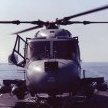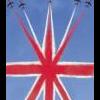-
Posts
1,945 -
Joined
-
Last visited
Chewbacca's Achievements

Very Obsessed Member (5/9)
5.3k
Reputation
-
IIRC from when I've used it on cars, it gets quite hot when it cures. Does it not warp the plastic?
-
Wish I could. I find Milliput to be the most confounded of substances. Doesn't adhere to anything other than my fingers and when it goes hard, it goes so hard that even a Dremmel barely makes an impression on it. If I were doing this now I would go for the 3D printing option but historically I would have used a plasticard skeleton and something like Humbrol or Revell filler with final gaps filled with Vallejo putty. Quite correct for the engines. AH9A had the upgraded Honeywell LHTEC CTS800 engines, the same as fitted to the Wildcat AH1/HMA2. These produce about 20% more power than the Rolls Royce Gems that they replaced but crucially produced that power in the hot and high altitude conditions needed for operations in Afghanistan. The Gem 205s that were fitted to the Lynx HMA8s, which for the most part operated at lower level, were considered adequate and so the Navy had to wait until the Wildcat entered service in 2015. I can't remember when exactly the 9A entered service but it was around 2009/2010. Even though I helped author the Wildcat HMA2 Aircrew Manual, I only did the left hand seat aspects (so radar, tactical system, FLIR etc) but seem to recall that the Wildcat gearboxes were not the same as those fitted to the 9A which were legacy Lynx. Don't quote me! While I was at Handling Squadron writing the Wildcat document set (amongst other things :)), I used to spend a fair bit of time down at Yeovil at Westlands as it was then with the Chief Test Pilot and aircraft design team. I seem to recall them saying that there were only about 6 panels that were common to the Lynx and Wildcat. I've often wondered, given that the AH1 has been in service for over 10 years now, why no one has kitted a Wildcat. Good work coming along here. If it's even half as good as XZ229 it will be a cracking model.
-
Really pleased this has climbed down from the shelf of doom Crisp and great work going on. I have had one of these in my stash for ages with the intent of converting to the earliest iteration of ARK V when she first sailed from the Tyne in November 1984 under the Red Ensign fir Contractor's Sea Trials...with the RNHF Swordfish embarked. I was OOW1 (and am on the bridge in the photo below), my last watchkeeping job before I started flying training in Feb 85. I must read this whole thread to properly get my head around the differences between the kit and early ARK
-
Totally agree. IIRC, FOD guards were not fitted when the OAT was below 3 deg or there was any risk of flight in icing conditions. Any in any case, the RBF blank with no FOD guard was a foam insert. Well somebody's got to do the After Flight Servicing 🤣 Great work Bill. That's a seriously impressive model.
-
Sorry, should have made it clear. The image of my partially complete flight deck is oriented with for'ard to the left
-
There were a fair few differences between XX910 and the production aircraft but I don;t think that anyone will really notice. Even in my 1/48 version you can barely see the 3 man seat with both cabin doors wide open! Does this help for position of the ringbolts? I can't find any definitive image that shows them so this is the best I have come up with from the photos I have for a 1/48 base. It's for HMS BRAVE so a Batch 2B but the stuff around the harpoon grid is pretty much the same. If you can find anything better please do let me know so that I can grab a copy for my own archive! I presume you've seen these two photos on militrayimages.net:
-
HAS 2/3, the tail rotor rotates anti-clockwise when viewed from port; in other words, the leading blade drives down into the downdraft from the main rotor disc. In the HMA8 they put a new tail rotor gearbox which reversed the direction of the drive. What difference does it make one might think? If the leading tail rotor blade flies up into the main rotor downdraft, it doesn't need to rotate to fast to generate the same lift over the blade. The HAS 2/3 tail rotor rotated significantly faster than the HMA8, which was the reason that you could frequently hear a Lynx from 6-7 miles away. It also led to a loss of tail rotor authority when approaching the operating limits. I'd always been led to believe that it was unique to the early Lynx variants and was caused by an error in the design shop. Until I was building my 1/48 Wasp and researched that aircraft to find that the Wasp was the same. I was also told that when they first reversed the direction, they did so by putting an additional cog in the intermediate gearbox, forgetting that the oil field in the tail rotor gearbox was worm drive fed and by reversing that, it sucked the oil out of the bearings not pumped it in. Apparently the gearbox disintegrated about 3 minutes into the first ground run. Pretty certain that the angled bar that you can see lined up next to the weapon frame is the hoist screw actuator strut which appears to have broken away from it's bottom mounting point. I think I can see the 3-man seat fitted up against the rear of the cabin but the fact that you can see the soundproofing on the far side of the cabin suggests to me there was no 6-man seat fitted. IIRC, the straps, which were 3 point shoulder/lap (like a car seat belt) were dark blue.
-
Bill, That "blocky thing" you refer to is the control box on the side of the hoist in the background. The weapons loading frame was just that, a frame. The lifting gear was a separate bit of equipment, carried out to the aircraft and hooked into the hole in the top of the lifting beam. These photos show it very well.
-
Thanks James. As originally built, she was built to the planned design of the other ships in the class but over the years she was altered as happens with any ship. I did think she wouldn't qualify. I'll think again.
-
Several pages ago I suggested that I might look at scratch building the MEKO A-200 RN that was one of the two offerings for the RN Type 31 frigate programme that didn't make it through, with the award going to the Babcock Arrowhead 140 instead. Well there are a few artists' impressions in open source but probably not enough to scratch build from, and even though I can get access to the actual general arrangement drawings, unfortunately they have not yet been down-classified so I wouldn't be able to take copies. So, would HMS BRISTOL qualify? BRISTOL was the first of the Type 82 destroyer programme, planned to be the first of a class of 8 whose design specification was to provide anti-air warfare escort duty for the projected new aircraft carrier, CVA-01. But when the RAF managed to persuade ministers that they didn't need to invest in a new carrier, because their aircraft could reach every part of the globe in which Britain had an interest (only by moving Australia several thousand miles on a map mind you 😠), Denis Healey, the then Defence Secretary, cancelled CVA-01. De-facto, if there was no CVA-01, there was no need for 8 expensive escorts, and so the Type 82 programme was similarly cancelled. However, BRISTOL, as first of class, was still ordered from Swan Hunters and the decision was taken to continue with her effectively as a trials ship to de-risk future technologies which would eventually find themselves in the smaller and cheaper Type 42s. It would be a fairly extensive conversion from an Airfix County Class but certainly doable. But I'm not sure if it would count because although the programme was cancelled, BRISTOL herself was finished and did enter service. What do people think?
-

1:144 HMS Ark Royal IV (or Eagle perhaps)
Chewbacca replied to bootneck's topic in Work in Progress - Maritime
Hi Mike, Good to see this going again. IIRC, the way I did something similar (but I concede less complex) in my Mayfly scratchbuild was to draw the frame. Extrude it (in my case 1mm) and then use the loft tool to join the inner sides of the frame to each other. Worked well for the nose and tail cones Think there'll be some fun trigonometry in there though working out the angles! Alternatively, one of the members of our local model club is a professional CAD engineer. I can ask her how she'd tackle it if you like? -
By a strange coincidence, while waiting for my wife to get back last night I was scrolling though YouTube and came across this short Westlands promotional video from the late 1970s: There's some really good close ups of the Harpoon/Deck Lock in operation from 2:07 to 2:45. And MAD being reeled in and out (albeit in a Dutch UH-14) from 4:36 to 4:50. Hope that helps
-

1/192 HMS CAVENDISH - scratch built repair
Chewbacca replied to Chewbacca's topic in Work in Progress - Maritime
I totally agree, but I've never seen them bent out at 180 deg to each other looking like cat's whiskers! Sorry this isn't a great photo but I forgot to take a better one before I took my trusty cutters to them. And after replacing with something a little more realistic: [/url -
Hi Bill, The grabby do dah thingamabob was originally called the Harpoon. When the Lynx landed on, assuming the Pilot got it vaguely near the grid (which to be fair they did most of the time), the call went out from the Flight Deck Officer on Helo Intercom "342 (or whatever the side number was) locked on deck, Harpoon engaged". And that was absolutely fine until about 1989, by which time HMS CORNWALL had entered service. Because of course CORNWALL was the first RN ship to be fitted with the Harpoon GWS 60 anti-ship missile system. And when the Captain, Chris Wreford Brown (of HMS CONQUEROR vs Belgrano fame) heard "Haroon engaged", apparently he went ballistic. And very soon afterwards, the order was issued that from then on, it was to be known as the "Deck Lock". Again in the early days of Lynx operations, as soon as the Harpoon was engaged, the Officer of the Watch could start manoeuvring. Until, I think it was HMS HERMIONE in 1990, was goffered by a wave after the OOW started his turn with the Lynx locked on deck but before the lashings had been applied, And guess what? The Harpoon failed, the aircraft rolled over and went over the side. Fortunately, both crew got out with minor injuries. After that the ship had to stay steady until 4 nylon lashings had also been applied. That Airwaves PE looks nothing like a Harpoon/Deck Lock. You're right in that it is a cylinder, about 80 mm diameter, that has a rectangular box attached to the side which contains the manual switches. When stowed the whole thing sits inside the rectangular housing with just the dissimilar length pincers showing. When on deck, the pilot presses a button on the collective which uses hydraulic pressure to push the Harpoon down and towards the grid. Between the two pincers is a microswitch which when activated by touching one of the ridges of the grid, it allows hydraulic pressure to close the pincers together which grips the grid and theoretically at least, will hold the aircraft in place. Apparently, though I've never seen a photo from the right angle to back it up, COVENTRY's Lynx was still secured to the grid by just the harpoon as she capsized. But COVENTRY survivors who witnessed it from the liferafts have told me and I have not reason to doubt them. I think the photo below is the furthest over I have seen her that clearly shows the cab still on deck with no lashings. The Harpoon in the Airfix 1/48 HMA 8 is a pretty good representation and hopefully this photo montage shows it reasonably well The reason that I haven't fitted this yet is that although the model is compete, the flight deck base and grid are not. I was going to fit this to the grid first then work out how much I need to lengthen it to allow for the head being extended. As for the MAD Operator's seat, I am not 100% certain, but I am 99% certain, that the MAD was operated by the Observer. There was nothing in the Lynx Aircrew Manual from back in the day that spoke about any single seats in the cabin apart from the Observer instructor's seat which fitted between and just behind the front seats and that certainly was never used for anything other than instruction. How the MAD was displayed to the Observer I do not know. In fact for that matter I don't even know if it had a display or just an audio warner if it detected something. Not Action Stations but Defence Watches. If they were at Action, the Anti-Flash hood would have been up. The Task Force was in Defence Watch for all of the time it was inside the Total exclusion Zone Normally I would expect it to be at the top. But given that all other markings have been erased, I would be surprised if there was one there at all by this stage of the war. Great work on that MAD winch/bird.








